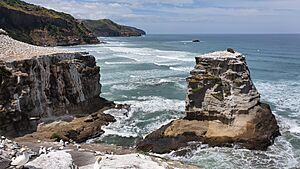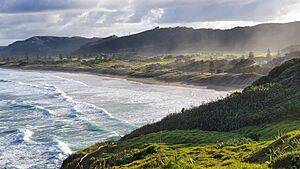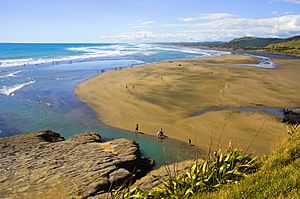Muriwai facts for kids
Quick facts for kids
Muriwai
|
|
|---|---|

Muriwai Beach
|
|
| Country | New Zealand |
| Region | Auckland |
| Ward | Rodney ward |
| Local board | Rodney Local Board |
| Subdivision | Kumeū subdivision |
| Electorates |
|
| Area | |
| • Total | 3.02 km2 (1.17 sq mi) |
| Population
(June 2023)
|
|
| • Total | 1,390 |
| • Density | 460.3/km2 (1,192/sq mi) |
Muriwai, also known as Muriwai Beach, is a cool coastal town on the west coast of New Zealand's North Island. It's famous for its black-sand surf beach. Many people from Auckland love to visit Muriwai for fun activities. The Muriwai Regional Park is also home to a huge group of gannets, which are amazing seabirds!
The name Muriwai means 'water's end' in Māori.
Contents
How Muriwai Was Formed
Millions of years ago, between 3 and 5 million years, the land where Muriwai now sits rose up from the ocean floor! Much of Muriwai's landscape was shaped by an ancient volcano called Waitākere Volcano. You can even see cool 'pillow lava' formations along the cliffs. The area is mostly made of sand, rocks, and cliffs.
Muriwai Beach has special black sand. This sand gets its color from iron that came from old volcanoes in the area. One of these was the huge Kaipara Volcano, which erupted 23 to 16 million years ago. The black sand moves along the west coast of the North Island over time.
Oaia Island is a small island located just off the coast of Muriwai.
Amazing Animals and Plants
Australasian Gannets
Motutara Island at Muriwai is a special place for Australasian gannets. It's one of the few places where these seabirds nest on the mainland. You can often see them flying and diving for fish.
Korowai Gecko
The rare korowai gecko is a special lizard found only in the Muriwai area. It mostly lives in the sand dunes along Muriwai Beach.
Muriwai's Past
Early Māori History
The Muriwai area has a rich history with the Tāmaki Māori tribe Te Kawerau ā Maki. They originally called the beach One Rangatira, meaning "The Chiefly Beach." This name came from a visit by a wise leader named Rakatāura.
Muriwai Beach is very important to Te Kawerau ā Maki. It's part of Te Rerenga Wairua, which is believed to be the path that souls take to Cape Reinga when they leave the world.
Te Kawerau ā Maki and another tribe, Ngāti Whātua, used to have disagreements over the land. Muriwai became known as the border between their lands after a peace agreement was made. Later, a group called Ngāti Te Kahupara, who were related to both tribes, lived in the area until the 1900s.
Whale Strandings and Old Villages
The southern part of Muriwai Beach was also called Paenga Tohorā, which means "Whale Resting Place." This name came from the many whales that would sometimes get stranded there.
An important chief named Te Au o Te Whenua lived at Te Korekore, a fortified village on a headland at the south end of the beach. He was known for collecting and drying Paphies ventricosa (toheroa), a type of shellfish, from Muriwai. He would trade these with other Māori tribes for special foods.
The gannet colony's headland was called Ōtakamiro. It had a village named after an ancestor called Takamiro. Other villages and fortified places were located nearby. The modern name, Muriwai, means "End of the Water." It comes from Te Muriwai, a settlement along the Ōkiritoto Stream, which eventually gave its name to the whole area.
Recent History
In the late 1800s, a man named John Foster started a flax mill in Muriwai, but it closed in 1893. In 1894, Muriwai Valley School opened, but it only operated part-time because of its rural location. Around the year 1900, Edwin Mitchelson, who was once the Mayor of Auckland City, built a large wooden house in Muriwai. He named it Oaia, after the nearby Oaia Island.
During World War II, the New Zealand government worried that the Japanese army might try to invade Auckland by landing at Muriwai. Because of these fears, a United States Marine Corps camp was set up in Muriwai.
In 1962, Muriwai became a very important place for communication. It was where the COMPAC submarine communications cable connected Auckland to Sydney, Australia. This cable helped send messages across the ocean until it stopped working in 1983.
Where is Muriwai?
Muriwai is about 17 kilometers west of Kumeū. It's also about 42 kilometers northwest of Auckland city. It sits at the southern end of a long, 50-kilometer stretch of beach that goes up the Tasman Sea coast towards the Kaipara Harbour.
Muriwai is one of several popular beaches in the area, along with places like Piha and Karekare. During summer, many people from Auckland visit Muriwai, making its population grow a lot! It is part of the Rodney Ward in the Auckland Region.
Fun Activities at Muriwai
Muriwai is a great place for many outdoor activities:
- Surfing: This is the most popular activity at Maukatia (Maori Bay) and Muriwai Beach.
- Paragliding and Hang Gliding: You can also see people paragliding and hang gliding, especially when the wind is just right.
- Fishing: Fishing is popular, but it's important to be careful as some spots can be dangerous.
- Bush Walking: There are special boardwalks and walking trails, including parts of the 'Hilary Trail', that let you explore the natural beauty.
- Beach Driving: Driving along the beach is popular, especially during fishing competitions.
- Surf School: You can rent surfboards, get surfing lessons, and even try sand yachts at the Muriwai Surf School.
- Mountain Biking: There are many mountain bike trails in the pine forests, especially for downhill and freeride biking.
- Surf Lifeguards: During summer, surf lifeguards are on patrol every weekend to keep everyone safe. They also train young lifeguards.
- Horse Riding: Horse riding is a popular way to explore the beach and the tracks behind the sand dunes.
Shark Encounter in 2013
In February 2013, a filmmaker named Adam Strange was swimming about 200 meters from Muriwai Beach when he was attacked by a small group of great white sharks. Sadly, he did not survive. As a result, Muriwai Beach was closed for several days. This was the first time someone had died from a shark attack in New Zealand in over 30 years.



